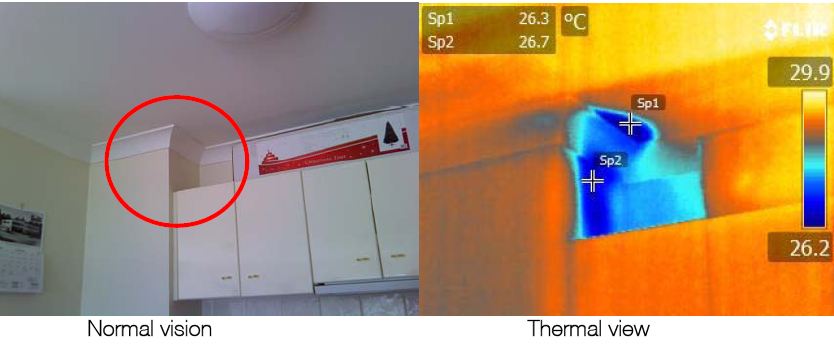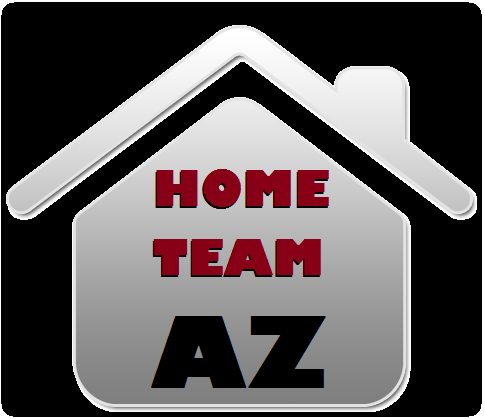Leaks to your indoor plumbing in Phoenix AZ:
1) Why are leaks important?
a) risk of water damage
|
2) What will we do about leaks?
a) prevent more serious leaks
|
The two questions above are detailed below. Note first that the article below is about the best approach to plumbing leaks that are specifically in the interior plumbing of your home or commercial building in Phoenix AZ. So, this article is not about leaks to plumbing under or outside of the building (or other leaks, like from damaged roofs above), although we will help you with any type of leak.
Indoor plumbing includes all of the plumbing components that you use to briefly produce a flow of water, such as a
toilet, a shower, a dishwasher, a faucet on a sink, or even a washer in your laundry room. Other indoor plumbing parts that may have water flowing through them for longer periods of time (and that you do not manually turn on and off throughout the day) would be the
hot water heater, the refrigerator (including the water line to the ice maker), and the air conditioner or swamp cooler.
Leaks relating to those interior plumbing components deserve some special attention. Briefly, the 3 reasons for that special attention are, first, that leaks can cause structural damage to the building in Phoenix. Second, leaks can create a risk of physical injury (from walking on slippery surfaces and falling). Third, leaks can produce mold contamination and water damage. (All three of those issues are detailed below.)
So, those
leaks to the interior in your home or commercial building deserve a different level of attention than exterior plumbing leaks (or a leaking roof). While exterior plumbing leaks are also best to prevent or detect quickly, those are a distinct class of plumbing problem.
Those exterior leaks can produce significant loss of water, which can be messy and even smelly, but they usually involve heavy-duty parts that fail less frequently and can properly functional without
repair or replacement for several decades. That is simply not the case for the most tender parts of your interior plumbing. A rubber seal that last decades in another climate can disintegrate much faster in the dry heat of Arizona, right?
So, before we move on to our main focus, note that some of the leaks that are not discussed below would be leaks in plumbing lines that are buried out in the yard (like in the main supply line, the
sewer line
or the landscape irrigation system) or outdoor leaks under the foundation or slab. If you have a concern or question about one of those exterior plumbing leaks, simply contact us immediately.
Now, if you have ever had a leak in those "exterior" plumbing systems, then you may know that those leaks certainly may have some similar consequences and complications to what is listed below. However, this article focuses specifically on leaks to indoor plumbing, including in a kitchen or bathroom, in an
attic or crawl space (such as from the air conditioner), or even inside a wall.
In general, feel free to contact us if you have a question about ANY kind of leak. In fact, in many cases, people develop a concern with a possible leak, but do not yet know the specific source of the leak. (One section below focuses on leak detection and, if that is all you need, then you can contact us about that now.)
1) why are indoor leaks so important?
a) leaks can cause structural damage to the building
To me, a very important issue with leaks is that if your plumbing starts to leak and it is not quickly repaired, then even a small leak (if it is leaking for a long time) can lead to severe damage to the structure of your home or commercial building in PhoenixAZ. That structural water damage can lead to large fractions of the drywall in your home needing to be torn out and completely replaced. Furniture is often destroyed by water damage. Belongings like books and computers can also be ruined.However, to me, physical damage to the building is actually not the biggest risk with leaks. To me, the risk of physical injury is actually a bigger cause for caution. (Of course, in severe cases of structural damage, like a ceiling suddenly collapsing, structural water damage can directly lead to physical injury.)
b) leaks create a risk of physical injury
A very serious concern with leaks is that even a small leak can result in unexpected moisture on flat, hard flooring (such as tile). What happens when someone walks on wet tile (especially if they do not know that it is wet and slippery)? What if the person wakes up in the middle of the night in the dark and they storm in to a dark room and rapidly walk across some slippery tile? What if the person is a toddler or a pregnant woman or an elderly person who is physically unstable? What if they are carrying something sharp (like a steak knife) or very hot (like a full mug of steaming coffee) when they slip and fall?Note that the most dangerous leaks (at least in relation to the issue of slipping and falling) can involve very small amounts of water. In contrast, when a pipe bursts, large gushing floods make noise and splash water around, so people know that there is water on the floor. Small leaks eventually lead to an accumulation of moisture that will surprise anyone who steps in it.
In those cases, there is very little noise produced by a slow accumulation of water, like with a pinhole leak or a drip from a cracked seal or slightly leaking valve. During a dry period (with low humidity), these leaks can go undetected for quite a while if the moisture dries almost as fast as it is leaking. But what happens when the Arizona summer arrives with higher humidity for months at a time? Suddenly, the moist air increases the drying time for any moisture that has accumulated from a small leak. That can lead to slipping and falling or worse.
So, even very small leaks can lead to significant amounts of moisture accumulating on tile flooring (or even underneath the tiles). Those small slow leaks are more likely to produce a physical injury from an accidental fall.
(On the other hand, if your toilet overflows and there is a flood of water as the toilet keeps running, you probably notice that fast. There is certainly still a real risk of slipping and falling, but at least there will be an immediate awareness that there is a lot of water collecting on the floor, so it is best to move very cautiously over a floor that is obviously going to be slippery).
c) leaks can produce mold contamination and water damage
On the subject of health risks, another issue which can go undetected for quite a while is mold. Note that molds are types of fungus (along with candida yeast infections or "athlete's foot").So, even small leaks can eventually result in a slow build up of moisture in the walls or attic. That can lead to the growth of mold, which can produce serious health issues with no immediately obvious cause.
People who spend a lot of time in a home or workplace in Phoenixthat is contaminated with mold can still be severely ill even without knowing that there is any issue with mold growing. According to an article on the CDC website on toxic mold indoors, common symptoms include "nasal stuffiness, eye irritation, wheezing, or skin irritation." More severe reactions (for people with allergies or compromised immune systems) "include fever and shortness of breath." Further, when there is mold damage to a building in Phoenix, the restoration process is much much elaborate. Not only will significant amounts of material need to be removed and replaced, but special precautions need to be followed during the removal of mold-contaminated materials in order to avoid the mold spores being released in to the air that flows in to the rest of your home or commercial building in PhoenixAZ.
2) what you can do about indoor leaks?
In the following section, we will review the following steps relating to leaks:a) ideally, preventing almost all leaking
b) detecting leaks
c) cutting off the flow of water
d) replacing leaking pipes & plumbing
e) repairing the damage caused by leaking water, flooded plumbing, and resulting mold contamination
A) Leak prevention in Phoenix AZ
Many people in Phoenixare not aware of the typical lifetime of various common plumbing parts. There are many valves and seals that will require regular replacement or else they will leak. Especially in the unusually dry climate of Phoenix Arizona, certain rubber plumbing seals will eventually disintegrate. They do not magically last forever! So, if you have an older building in Phoenix, there may be quite a few hidden and inexpensive parts that could result in a leak and water damage.What do we recommend? Annual inspections and ongoing maintenance can prevent the most common sources of indoor plumbing leaks. A regular maintenance protocol will include an inspection of the most frequently used parts in your indoor plumbing in Phoenix. That includes all faucets, toilets, and the drains under sinks.
Further, hot water heaters typically need to be drained every single year. In many cases, the warranty covering malfunctions and replacement of your hot water heater will specify that the warranty is only valid if there is an annual draining of the water heater.
In addition to leaks in water heaters or the other plumbing components that you regularly turn on and off (or flush), another potential source of leaks in the ice maker line that connects to your refrigerator. In fact, regular inspection and replacement of those less obvious plumbing connections is a common cause of serious water damage and even mold contamination.
Note that when you use something frequently, like a toilet or a drain under your kitchen sink, then you are going to notice problems quickly. If there is a tiny leak in your bathroom facuet, then you will probably notice it when it is still extremely small. Further, water may only flow a few minutes per day through those parts.
In contrast, there can be much more frequent water flow in equipment that you may not look at on a daily basis. That includes appliances like the hot water heater, the air conditioning, and the refrigerator's ice maker.
Imagine that, if there was a small leak involving any of those appliances, it could be hours or even days before you find out about the leak. Maybe the leak gets worse in that time. Maybe by the time you find out about the leak, a significant amount of water has flooded in to the building, the flooring, and even in to walls and across kitchen cabinets. If the water is accumulating for more than 48 hours, the potential for a hidden growth of mold arises.
So, while an emergency repair plumber in Phoenix. gets more calls for failures in the obvious plumbing components that people use several times per week or per day, the biggest source of flood damage from interior plumbing leaks are the appliances that we do not manually turn on and off (or flush). The water lines on those appliances are constantly open. A leak or broken pipe in the wrong place on one of those lines can lead to significant amounts of water damage even from a tiny pinhole leak.
If there was a tiny leak in a faucet that was only flowing with water a few minutes each day, you could go for months without any problem from that, right? So, when you think about an annual plumbing inspection and maintenance service in Phoenix, do not just think about opening the back lid of the toilet and replacing a few broken chains or valves. Your annual leak prevention protocol is not to check for issues that would instantly be obvious to the homeowner in Phoenix. The service is for the purpose of inspecting things that you normally ignore, like an emergency shut-off valve.
Note that you almost never use that valve. As the name suggests, it is only used in emergencies. However, in the even that you need that valve to work and it is not functional, the consequences can be costly. If you request for our plumbers to do an annual maintenance service at to your home or building in Phoenix, not only will we inspect the most important parts of your indoor plumbing, but we will bring the replacement parts that are most common with us. It is best that these inexpensive but important parts be replaced prior to them failing and causing a serious leak. We recommend an annual inspection and in that inspection, the plumber can assess the condition of the parts that are most likely to produce big problems, then replace whatever parts need replacing.
b) detecting leaks
Many residential plumbers in Phoenix simply rely on their eyes and expertise to determine the source of leaking water. In many cases, the homeowner will also already know the exact source of the leak. However, sometimes the source of the water is harder to determine, and so there is the additional issue of detecting the source of the leaking water, which is the topic of this short section.Contractors who provide home inspections or who provide water damage restoration services (or flood damage repair) have special equiment for detecting leaks through the use of thermal infrared imaging. Basically, the infrared ("IR") cameras reveal different temperatures, such as in a wall or ceiling.
 In the normal view on the left side of the image, there is nothing obvious about the area in the red circle. However, through thermal imaging, it is very easy to see the dark blue areas which direct us back to the source of the leaking (which are labeled Sp1 and Sp2 in the right side of the image). The lighter blue areas show where water from the two main leaks is accumulated, resulting in temperatures there that are lower than in the yellow and orange areas.
In the normal view on the left side of the image, there is nothing obvious about the area in the red circle. However, through thermal imaging, it is very easy to see the dark blue areas which direct us back to the source of the leaking (which are labeled Sp1 and Sp2 in the right side of the image). The lighter blue areas show where water from the two main leaks is accumulated, resulting in temperatures there that are lower than in the yellow and orange areas.
These IR thermal imaging cameras can be used for a variety of purposes, including measuring the quality of the insulation behind a wall or above a ceiling. Home inspectors can determine which windows are really air-tight and which ones needs a new layer of caulking. Windows that are not water-tight can even be a source of water damage and mold contamination.
But with our focus on indoor plumbing leaks, the value of these infrared cameras is to allow us to pinpoint leaks in the plumbing that is between floors of a multi-story house or inside of the walls. Leaks cannot hide from these cameras. In only a few moments, immediate clarity about the source of leaks can be recorded and documented.
c) cutting off the flow of water
Once the source of the leak has been detected, the next step is to stop any active flows of water to the leaking plumbing. Usually, that is simple.However, back to the issue of the value of annual plumbing maintenance services, it is not unusual for homes in Phoenixto have inoperative shut-off valves. Many people do not replace those valves within the normal lifetime expected by the manufacturer.
So, if we are going to replace some leaking pipes, first we will cut off the water to stop the flow. In some cases, that requires turning off the water to the entire house. Whatever shut-off valve is nearest and working is the one we will engage. Then, the flow or water to the leak will be interrupted. Next, inoperative parts can be repaired or replaced without any active flooding.
d) replacing leaking pipes & plumbing in Phoenix
This step is the most obvious. If the leak is small and was quickly found, then there may be little left to do after the new replacement plumbing is installed. If we are certain that the leak has been active for less than 48 hours, we be confident that mold is not an issue and simply may place some fans to accelerate drying.However, if there is a concern about the leak producing water damage or mold, then the final step below will also be relevant. Further, if someone has not already been doing annual preventative maintenance, then we may discuss or begin those activities once the main leak has been resolved.
e) repairing the damage caused by leaking water, flooded plumbing, and resulting mold contamination
There is a limit to the amount of remodeling that the average residential repair plumbing will be willing and able to do. Plumbers install hot water heaters and things like sinks, but do not usually provide any water damage repairs beyond that.So, this is the point where the work of the plumber may end and the work of the home insurance company may begin. Once a restoration supervisor has conducted an assessment of water damage to the building in Phoenix , then the insurance company can be contacted to confirm the extent of coverage for any restoration services that are relevant after the flooding from the leak. The remodeling to replace everything that has sustained water damage can be directly approved by the insurance company.
Any damage that is not approved as covered under the home owner's insurance can be identified as outside of the policy. If there are unpaid deductibles that the homeowner (or owner of the commercial building) will need to pay, then those transactions can be planned, completed, and documented for the insurance company so that the policy is triggered in to effect.
When there is a need for damage restoration for you in Phoenix, you may be very focused on quickly repairing water damage or mold damage, especially if it is severe. Once the need is identified, people are usually very motivated to proceed immediately with the relevant emergency repairs.
On occasion, there will be some stress in regard to how to pay for a desired damage restoration service. In some cases, people who do not already have an available credit line on credit cards can still qualify for financing of their restoration service at a low interest rate. For landlords in Phoenix, they may even have an legal obligation to immediately initiate repairs for flood damage from water leaks. Once you are clear on what needs to be done to restore the building to it's prior condition, then you can plan the timing of the actual remodeling and restoration service.
Leaks in Phoenix AZ?We will provide you emergency plumbing repairs
|
Service area in AZ:West of PhoenixEast of Phoenix North of Phoenix & beyond WEST OF PHOENIX: Avondale Buckeye El Mirage Glendale Litchfield Park Peoria Tolleson Sun City Surprise Waddell Wittmann Youngtown EAST OF PHOENIX: Apache Junction Chandler Florence Fountain Hills Gilbert Gold Canyon Mesa San Tan Valley Scottsdale Sun Lakes Tempe Queen Creek NORTH OF PHOENIX: Anthem Black Canyon City Carefree Cave Creek New River PLUS: Ahwatukee Paradise Valley PHOENIX Laveen Guadalupe Maricopa |



